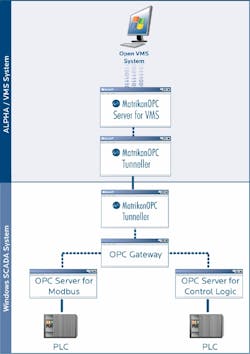Steel Company Uses OPC to Help Meet EPA Emission Standards
As process technology moves forward, high-capacity data infrastructure is moving from being the next big thing to being the expected norm. Systems that have been reliably running processes for years or decades are unable to support the data-intensive optimization programs that are driving plant competitiveness. Without reliable high-density data acquisition and storage, many plants can struggle or fail to meet strict environmental emissions reporting requirements.That’s the situation Matrix Technologies Inc., of Toledo, Ohio, faced when it was contracted to upgrade the Level 2 Supervisory Process Control system for a basic oxygen furnace at one of steel giant AK Steel’s mills.The purpose of the system is to capture information in real time about oxygen being blown into the vessel during certain points of the heating process, and to transmit information from model and strategy calculations made by models on the Alpha system to the programmable logic controller (PLC).“It’s a batch process,” says Steve Goldberg, of Matrix Technologies. “The company adds certain fluxes and alloys to make certain grades of steel, but the large part of the process is blowing oxygen into the steel. As part of that there’s an off-gas system, which is a negative-pressure system used to suck off the bad gases, scrub them and clean them to meet certain Environmental Protection Agency (EPA) guidelines for contaminant.”Those EPA standards helped to drive the upgrade. Reporting requirements call for a massive amount of data to be recorded in specific detail, with a high degree of reliability. Missing data can lead to major regulatory trouble, including heavy fines.The company was upgrading to meet emission standards didn’t feel it could achieve the goals of the emission standards by trying to make changes on the old system. The HP platform at the supervisory level was considered to be obsolete. The company also had a combination of older model Square D brand PLCs, which were being replaced by Rockwell Automation’s ControlLogix PLCs.There were serial ports coming out of the old HP computer that were clocking about 9600 baud directly to a serial port on one of the Square D PLCs. There was also another serial port that was connected to an intermediate system, and the intermediate computer was connected to a different Square D PLC.While the legacy system was functional, it didn’t have the bandwidth required to meet AK Steel’s data-collection requirements, it couldn’t support two-way communications, and it lacked the capacity for future expansion.Matrix Technologies’ solution involved an OpenVMS Alpha computer that needed to share real-time data with PLC devices, both ControlLogix and Square D PLCs. After considering the requirements and those of the client, Matrix Technologies contracted with MatrikonOPC, based in located in Edmonton, Alberta, Canada, to write the MatrikonOPC Server for OpenVMS. The server was then implemented using the GenCS component in a Windows environment. MatrikonOPC Data Manager was used to provide an OPC bridge between the RSLinx, a PLC server for Rockwell Automation controllers, and the Intellution Modbus Ethernet driver.Matrix went with OPC in its solution because it did not want to incur the time or expense of writing custom protocols. OPC was as close to an off-the-shelf solution as they could find. In a nutshell, the solution was to allow two-way communications between the OpenVMS system and the plant floor.As well as being able to deal with multiple data types, the OPC GenCS can handle 2,500 updates per second—more than enough to ensure the mandated detail and integrity of data collection and storage.The alternative was to have a SCADA system sit in the middle between the PLCs and the Alpha, which would result in some latency. Beyond the latency concern, AK Steel didn’t want the SCADA to have that much involvement in control. By using the MatrikonOPC driver for OpenVMS, the VMS computer can write a value into a global data variable that would be a tag that can be displayed on a SCADA screen. With OPC, any application can get access to the data pool.“We looked around quite a bit for somebody that could write the code. To be frank, when I was asking for guesstimates on how much it would cost, Matrikon was the most reasonable,” says Goldberg. He estimates that by using OPC rather than having custom drivers written, about $20,000 was saved on the project bottom line.The open nature of OPC will lead to further benefits to AK Steel as Matrix continues to make infrastructure upgrades. “Being that they have many OpenVMS systems within their mills, right at the outset they established that they plan to reuse this at other locations,” says Goldberg.For free downloads or more information visit www.matrikonopc.com.

